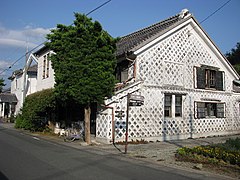
Kenzō Tange was a Japanese architect, and winner of the 1987 Pritzker Prize for Architecture. He was one of the most significant architects of the 20th century, combining traditional Japanese styles with modernism, and designed major buildings on five continents. His career spanned the entire second half of the twentieth century, producing numerous distinctive buildings in Tokyo, other Japanese cities and cities around the world, as well as ambitious physical plans for Tokyo and its environs. Tange was also an influential patron of the Metabolist movement. He said: "It was, I believe, around 1959 or at the beginning of the sixties that I began to think about what I was later to call structuralism",, a reference to the architectural movement known as Dutch Structuralism.
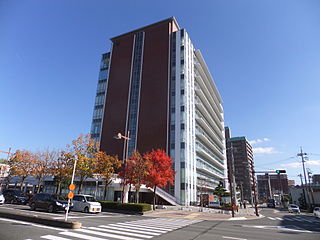
Higashihiroshima is a city located in Hiroshima Prefecture, Japan. As of 30 April 2023, the city had an estimated population of 190,186 in 90,294 households and a population density of 300 persons per km². The total area of the city is 635.16 square kilometres (245.24 sq mi).

Japanese architecture has been typified by wooden structures, elevated slightly off the ground, with tiled or thatched roofs. Sliding doors (fusuma) and other traditional partitions were used in place of walls, allowing the internal configuration of a space to be customized for different occasions. People usually sat on cushions or otherwise on the floor, traditionally; chairs and high tables were not widely used until the 20th century. Since the 19th century, however, Japan has incorporated much of Western, modern, and post-modern architecture into construction and design, and is today a leader in cutting-edge architectural design and technology.
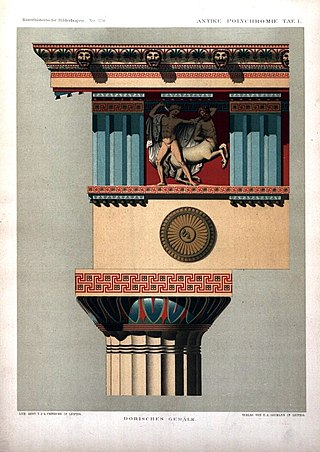
Polychrome is the "practice of decorating architectural elements, sculpture, etc., in a variety of colors." The term is used to refer to certain styles of architecture, pottery or sculpture in multiple colors.

Machiya are traditional wooden townhouses found throughout Japan and typified in the historical capital of Kyoto. Machiya ('townhouses') and nōka constitute the two categories of Japanese vernacular architecture known as minka.

Mudéjar art, also known as Mudéjar style, refers to a type of ornamentation and decoration used in the Iberian Christian kingdoms, primarily between the 13th and 16th centuries. It was applied to Romanesque, Gothic, and Renaissance architectural styles as constructive, ornamental, and decorative motifs derived from those that had been brought to or developed in Al-Andalus. These motifs and techniques were also present in the art and crafts, especially Hispano-Moresque lustreware that was once widely exported across Europe from southern and eastern Spain at the time.
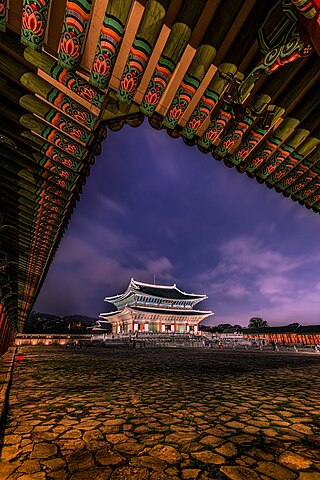
Korean architecture refers to an architectural style that developed over centuries in Korea. Throughout the history of Korea, various kingdoms and royal dynasties have developed a unique style of architecture with influences from Buddhism and Korean Confucianism.

Contemporary architecture is the architecture of the 21st century. No single style is dominant. Contemporary architects work in several different styles, from postmodernism, high-tech architecture and new interpretations of traditional architecture to highly conceptual forms and designs, resembling sculpture on an enormous scale. Some of these styles and approaches make use of very advanced technology and modern building materials, such as tube structures which allow construction of buildings that are taller, lighter and stronger than those in the 20th century, while others prioritize the use of natural and ecological materials like stone, wood and lime. One technology that is common to all forms of contemporary architecture is the use of new techniques of computer-aided design, which allow buildings to be designed and modeled on computers in three dimensions, and constructed with more precision and speed.

J. W. Sexton High School is a public school located on the western edge of Lansing, Michigan, United States, in the Lansing School District. The principal is currently Daniel Boggan. The Sexton J-Dubbs are members of the Capital Area Activities Conference. The school has a fierce rivalry with the Everett Vikings of Everett High School on the south side of the city. In March 2012 the Lansing School District announced that Sexton would house 7-12 grades beginning in the 2012–2013 school year.
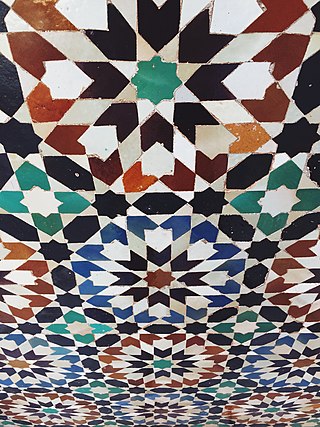
Zellij is a style of mosaic tilework made from individually hand-chiseled tile pieces. The pieces were typically of different colours and fitted together to form various patterns on the basis of tessellations, most notably elaborate Islamic geometric motifs such as radiating star patterns. This form of Islamic art is one of the main characteristics of architecture in the western Islamic world. It is found in the architecture of Morocco, the architecture of Algeria, early Islamic sites in Tunisia, and in the historic monuments of al-Andalus. From the 14th century onwards, zellij became a standard decorative element along lower walls, in fountains and pools, on minarets, and for the paving of floors.

Antonin Raymond, born as Antonín Reimann was a Czech American architect. Raymond was born and studied in Bohemia, working later in the United States and Japan. Raymond was also the Consul of Czechoslovakia to Japan from 1926 to 1939, in which year the Czech diplomacy was closed down after the occupation of the European country by Nazi Germany.
Saijō-chō was a town located in Kamo District, Hiroshima, Japan. The town is the administrative center of Higashihiroshima.

The Great Mosque of Herat or "Jami Masjid of Herat", is a mosque in the city of Herat, in the Herat Province of north-western Afghanistan. It was built by the Ghurids, under the rule of Sultan Ghiyath al-Din Muhammad Ghori, who laid its foundation in 1200 CE. Later, it was extended several times as Herat changed rulers down the centuries from the Kartids, Timurids, Mughals and then the Uzbeks, all of whom supported the mosque. The fundamental structure of the mosque from the Ghurid period has been preserved, but parts have been added and modified. The Friday mosque in Herat was given its present appearance during the 20th century.

Sukiya-zukuri (数寄屋造り) is one type of Japanese residential architectural style. Suki means refined, well cultivated taste and delight in elegant pursuits, and refers to enjoyment of the exquisitely performed tea ceremony.
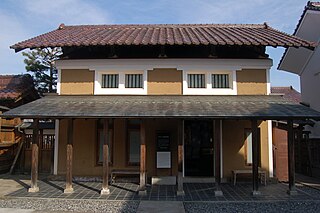
Kura are traditional Japanese storehouses. They are commonly durable buildings built from timber, stone or clay used to safely store valuable commodities.

Kura (鞍), is the generic name for the Japanese saddle. The word "kura" is most commonly associated with the saddle used by the samurai class of feudal Japan. Over time the Japanese added elements of their own until the Japanese saddle became an identifiable style, also known as the samurai saddle.

The Imperial Crown Style of Japanese architecture developed during the Japanese Empire in the early twentieth century. The style is identified by Japanese-style roofing on top of Neoclassical styled buildings; and can have a centrally elevated structure with a pyramidal dome. Outside of the Japanese mainland, Imperial Crown Style architecture often included regional architectural elements. Before the end of World War II, the style was originally referred to as Emperor's Crown Amalgamate Style, and sometimes Emperor's Crown Style.

The Kawagoe City Industry and Tourism Center is a commercial facility in Kawagoe City, Saitama Prefecture. It was established by Kawagoe City after converting sake storehouses of the former sake brewery. The facility opened on October 1, 2010 with the nickname of ‘Koedo Kurari’.
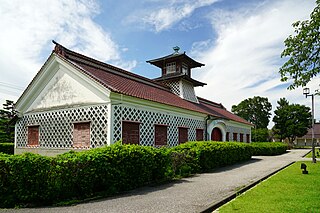
Former Niigata Customs House is an early Meiji period building in the city of Niigata, Niigata, within the MINATOPIA, or park surrounding the Niigata City History Museum. The building was designated an Important Cultural Property of Japan and a National Historic Site of Japan in 1969. The building is an example of Giyōfū architecture, mixing western and Japanese elements. The building has red roof tiles and arched doorways, combined with "namako-style" plaster walls and a pagoda-like tower.

Claremont Post Office is a heritage-listed post office at Bayview Terrace, Claremont, Western Australia, Australia. It was added to the Australian Commonwealth Heritage List on 22 June 2004.




